Are you looking to buy a new pet but cannot decide on the best Boston Terrier color? Well, today is your lucky day, as I’ve got you covered!
Boston Terriers are small dogs that are known for their beloved personalities, small size, and high activity levels.
What many people don’t know is that they also come in a wide variety of colors!
Some people might think that choosing a dog based on its color is shallow, but this is one of the important considerations you need to make before buying a dog.
But, why do colors matter, and just how many Boston Terrier colors are out there?
Let’s find out!
Recognized Boston Terrier Colors
First off, we’ll start with Boston Terrier colors that are up to the breed standard, at least according to the American Kennel Club (AKC).
Choosing a dog that comes in accepted colors has several advantages.
First and foremost, you’ll know that your dog has a pedigree and that the breeder in question has most likely chosen good parents, meaning you’re more likely to end with a high-quality, healthy dog that will adhere to the breed standard.
Next, if you’d like, you’d also be able to have these pups participate in conformation shows and other dog competitions – something that’s not possible if your dog is in the wrong color.
Also, it’s important to keep in mind that various kennel clubs accept different colors. For example, a dog that is up to the AKC’s standard might not be up to the standard set by the United Kennel Club (UKC) or Federation Cynologique Internationale (FCI).
Still, when talking about accepted colors, I’ll stick to the AKC’s standard, just to make things more clear.
Here are the colors your American Gentleman is allowed to come in:
1. Black And White Boston Terrier

Black and white is the most common and the most cherished Boston Terrier color combination.
These pups have a black base coat with white markings that form a standard tuxedo pattern. This means that the white covers the dog’s neck, chest, part of the front paws, and white muzzle.
While there are some other possible patterns, only the tuxedo one is considered desirable.
These dogs should always have dark eyes and black noses, lips, and eye rims. Blue eyes are possible but are typically a sign of bad bloodlines, so they are undesirable.
2. Brindle And White Boston Terrier

Brindle is not exactly a solid color but rather a pattern made from a combination of stripes on a base coat color, giving dogs a tiger-like appearance.
The exact color of brindle Boston Terriers depends on its genetics, as it can come in many different shades.
Typically, the base color is tan with dark brown or black stripes, but other combinations are possible.
The brindle pattern is intertwined with white markings located on the dog’s neck, muzzle, and front legs. Often, the white spreads between the dog’s eyes, but it shouldn’t be a full mask. Hind legs should always be brindle.
The white should never cover more than 49% of the dog’s coat. If this happens, the dog is considered white and brindle, which is a faulty color.
Just as is the case with black Boston Terriers, these pups should have dark eyes and black noses. Blue eyes are possible but are considered a fault.
3. Black Brindle And White Boston Terrier
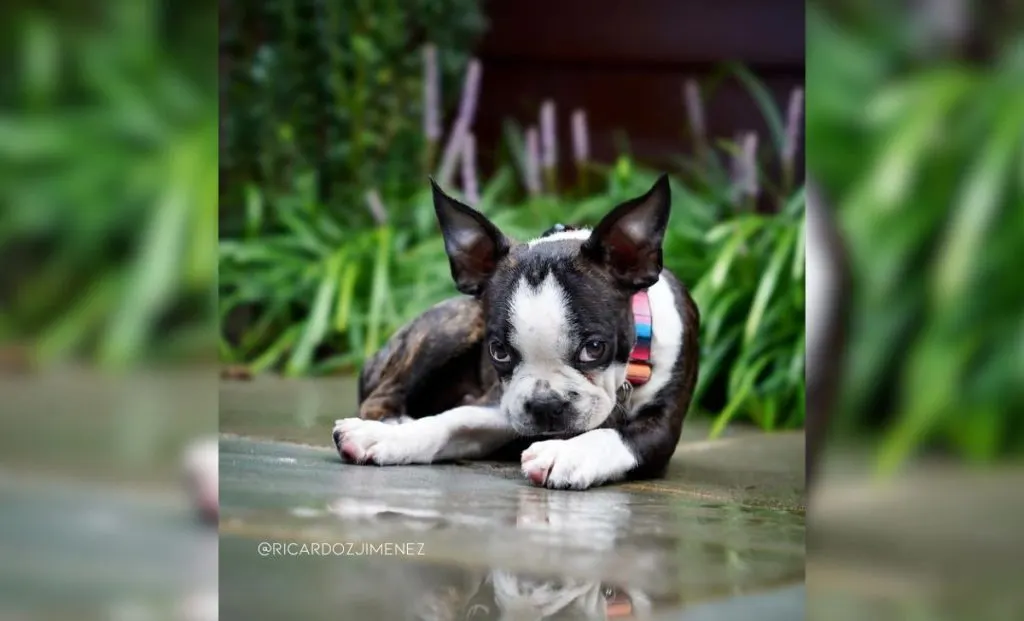
Black brindle and white Boston Terriers look the same as brindle and white doggos, but the brindle pattern is so dark it appears almost black.
This is a highly sought-after Boston Terrier color, and it’s pretty rare, too – although not as rare as some other color combinations.
Considering how beautiful this pup looks, this shouldn’t be a surprise.
4. Seal And White Boston Terrier
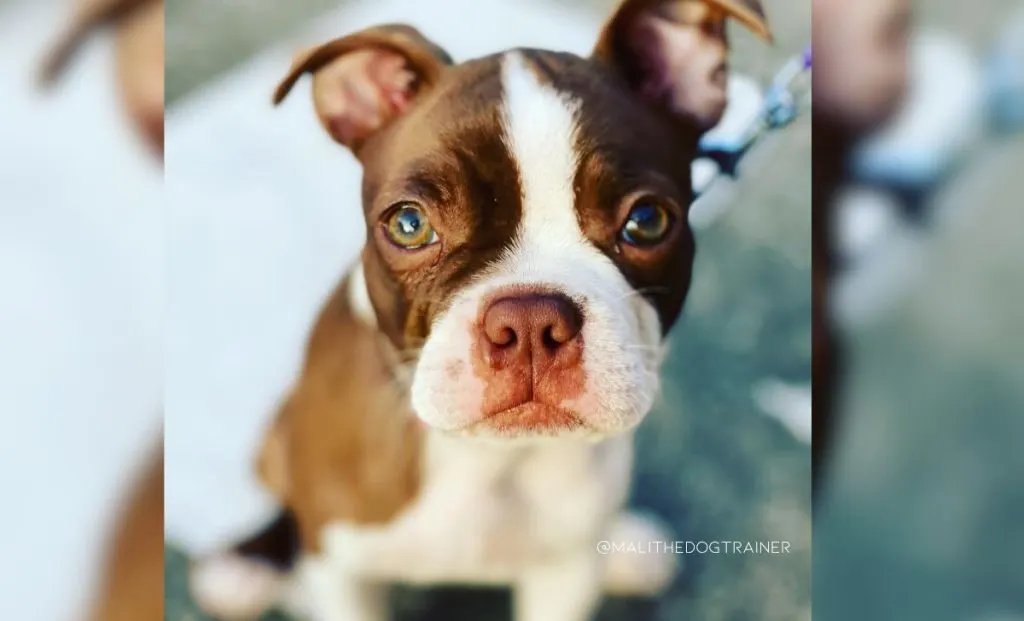
Seal is the rarest and, if you ask many prospective owners, the most beautiful Boston Terrier color out there.
This is a unique color that appears black at first glance. However, when the light shines in a specific way, you’ll notice a strong red tinge.
These pups have the same pattern as black and white or brindle and white dogs. The only difference is in the beautiful base color.
Also, their noses are black, and their eyes are dark.
5. Seal Brindle And White Boston Terrier
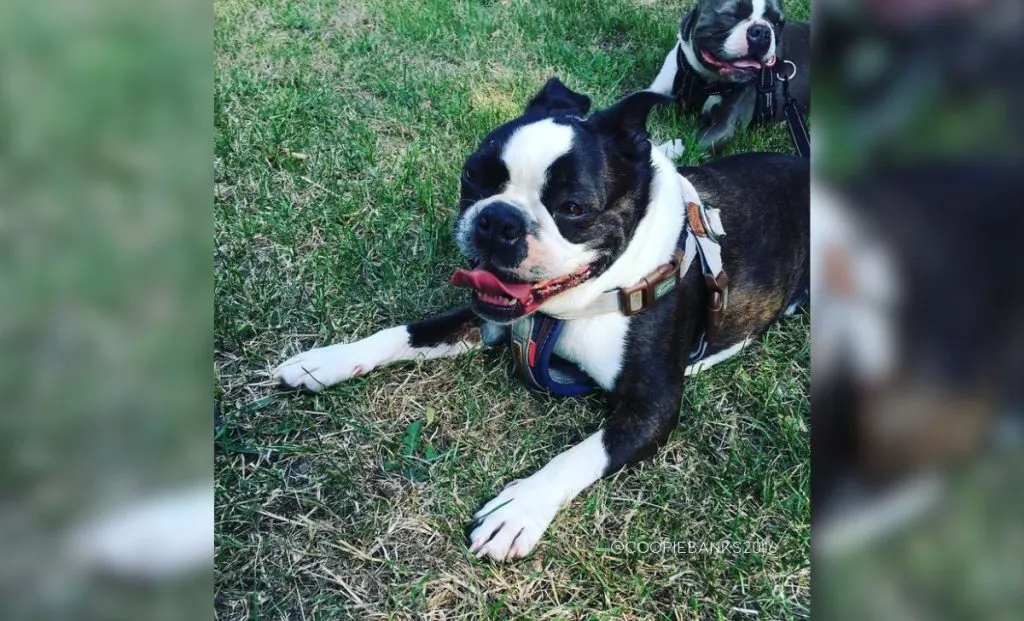
Seal brindle and white Boston Terriers are brindle Bostons with a seal as a base coat for the brindle pattern.
In other words, they have a seal base coat with black stripes and white markings that give them the appearance of wearing a tuxedo.
This is another rare color combination, and it might be quite difficult to notice at the first look.
However, once you do see the red coloration, you’ll see why so many people prefer this shade over the traditional black.
Non-recognized Boston Terrier Colors
If you look at listings by various breeders, you’ll probably notice some coat colors that weren’t on the above list. What does that mean?
While AKC recognizes and accepts only five Boston Terrier colors, this doesn’t mean a few other combinations aren’t possible.
However, there are usually very serious reasons why such color isn’t accepted.
Many of the colors I’m about to mention are an indication that your dog might be more prone to certain health conditions.
For example, dogs that have more white than color on their coats are typically more likely to get several possible illnesses, including skin conditions.
Not only that, but certain colors simply don’t exist in the dog breed’s natural genetics. In other words, the presence of that color is likely to indicate that the dog is, in fact, one of many Boston Terrier mixes.
While, of course, I cannot tell you what to do, most experts advise against buying dogs in colors that aren’t up to the breed standard. This is not only due to the possible complications but also because you’d be supporting bad breeding practices.
Still, no one can deny these pups are utterly beautiful, and it’s easy to see why they are so sought after.
Here are eleven more colors you can find Boston Terriers in:
1. White And Black Boston Terrier
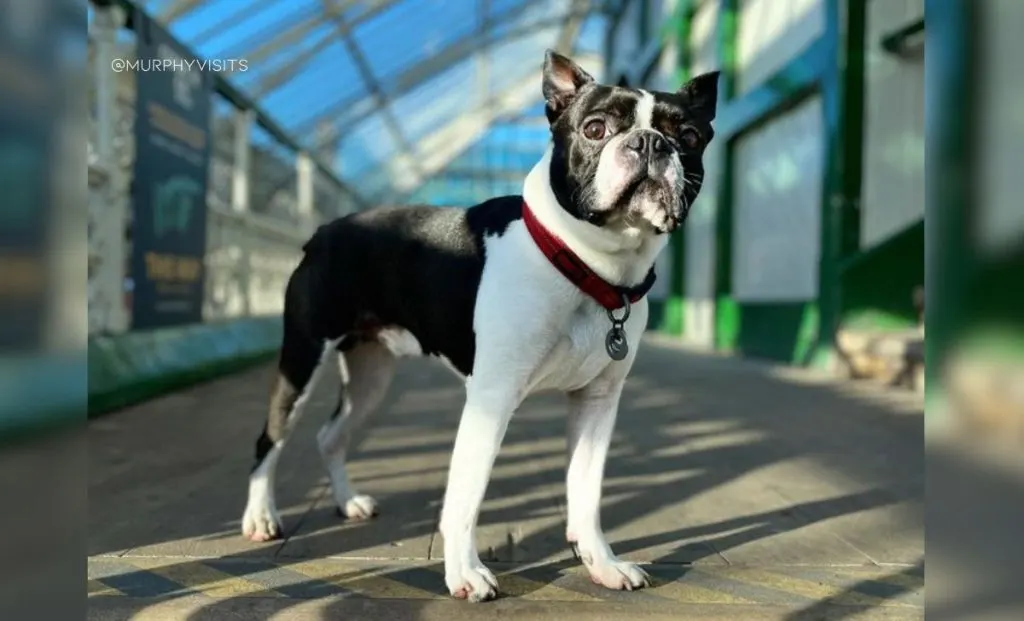
White and black Boston Terriers are quite similar to the black and white one, but with one major difference.
As their name suggests, their bodies have more than 50% white on them. This means their base color is white, and their bodies have black markings – the opposite of black and white pup.
These pups also have dark brown eyes, although occasionally partial heterochromia is possible.
White and Black Bostons are considered faulty and are not accepted by AKC, especially if their patterns are not traditional tuxedo ones.
2. White And Black Brindle Boston Terrier
Similar to the white and black pooch, white and black brindle Boston Terriers are Bostons with a white base coat and black brindle markings.
These pups are sometimes difficult to differentiate from white and black pups, depending on just how dark the brindle pattern is.
Typically, blue eyes are not possible in brindle-colored Boston Terriers.
3. White And Seal Boston Terrier
You probably already see where this is going.
White and seal Boston Terriers are Boston Terriers with a white base coat and seal markings. This is a rather unique and rare coat color that, sadly, is not accepted by the kennel clubs.
Just like the classic seal and white Bostons, these pups have to have black noses and dark eyes. Otherwise, they would be considered brown Boston Terriers.
4. White And Brindle Seal Boston Terrier
White and brindle seal Boston Terriers are the brindle seal and white Bostons with more than 50% white on their coats.
They look similar to brindle Boston Terriers, but upon closer look, you’ll notice the red shine their brindled markings have.
They are not a part of recognized standard, but are gorgeous and popular nonetheless, although they can be challenging to find.
5. White And Brindle Boston Terriers
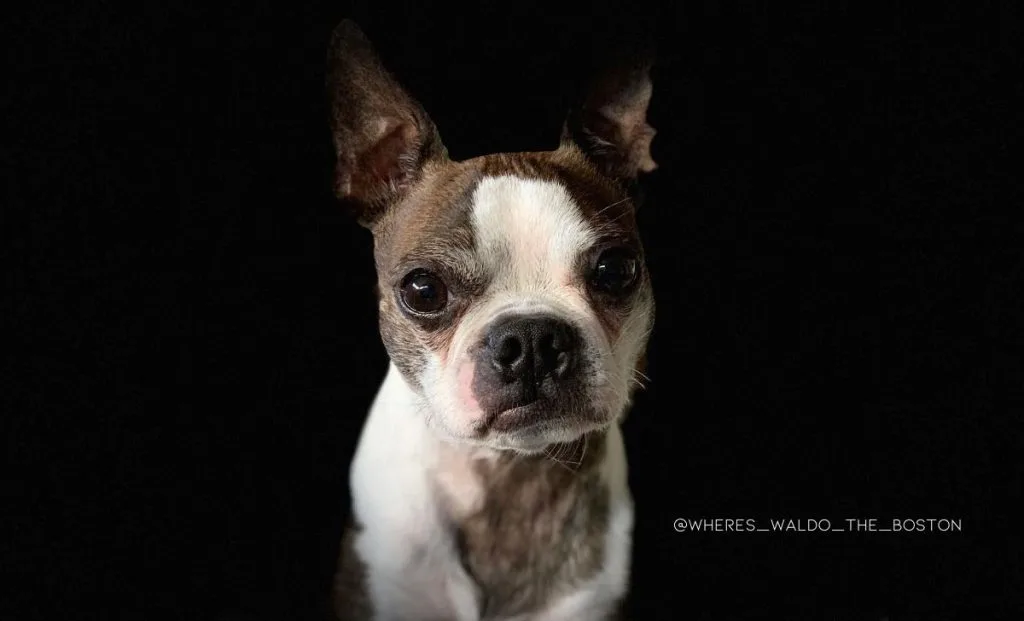
White and brindle Boston Terriers are not up to conformation standards, although they are quite similar to brindle and white ones.
They have a white base with brindle markings that don’t cover more than 49% of their coat.
As mentioned before, they’ll always have brown eyes, as blue eyes are challenging to come paired with the brindle pattern. They also have dark noses, lips, and eye rims.
6. Chocolate Boston Terrier
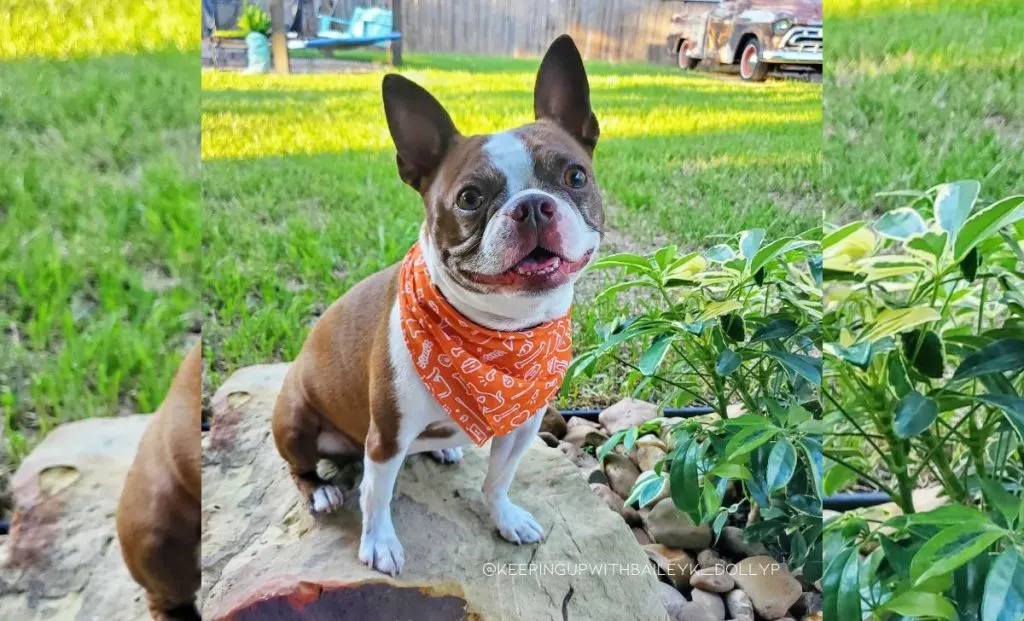
Chocolate Boston Terriers, also known as brown, are, in fact, brown Bostons with a dilution gene.
This gene affects all black pigment in the dog’s coat, turning it into a shade that varies from brown to liver. This includes not only coat color but also eye color and nose color. Their noses will be brown, while their eyes will typically be hazel or amber.
This gives these puppies their own unique look that is like no other.
Most of the time, these pups will have a brown and white tuxedo pattern. Sometimes, however, they might have more white than brown.
Considering how they are not up to the breed’s standard, their breeding is quite unregulated, which means there are fewer breeding regulations.
7. Red Boston Terrier
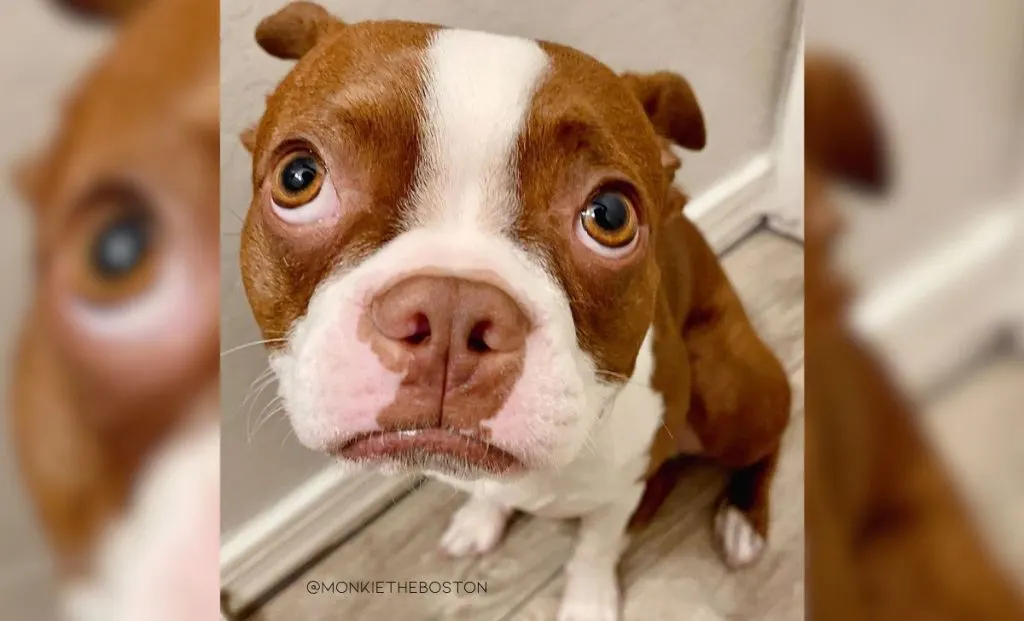
Red Boston Terriers are quite similar to chocolate Boston Terriers. They are also the product of diluted genes, but in this case, the coat shade is brighter, more resembling red or orange shades.
These doggos are one of the most beautiful pups out there. The red color gives these Bostons a gorgeous appeal that is quite unique, especially when contrasted with the white fur and their beautiful yellow eyes.
Unfortunately, these pups are not considered a part of the standard, considering how dilution genes are considered a fault.
8. Blue Boston Terrier

Blue Boston Terriers are the product of another dilution gene, except this time the black coat is turned into a unique shade of grayish blue.
Just as is the case with chocolate Bostons, this dilution gene affects more than just a coat, turning the dog’s eyes and nose to blue.
Blue Boston Terriers exist in both blue and white and white and blue patterns, just like their black counterparts.
It’s important to note that the blue dilution gene is connected with several genetic disorders, such as color dilution alopecia (CDA).
No, not all blue dogs will suffer from CDA, but this condition is only found in pups with dilution genes.
While blue is quite a common color in some dog breeds – such as Pitbulls – it is somewhat rare in Boston Terriers, although not as rare as white and seal brindle or cream and white.
9. Cream And White Boston Terrier
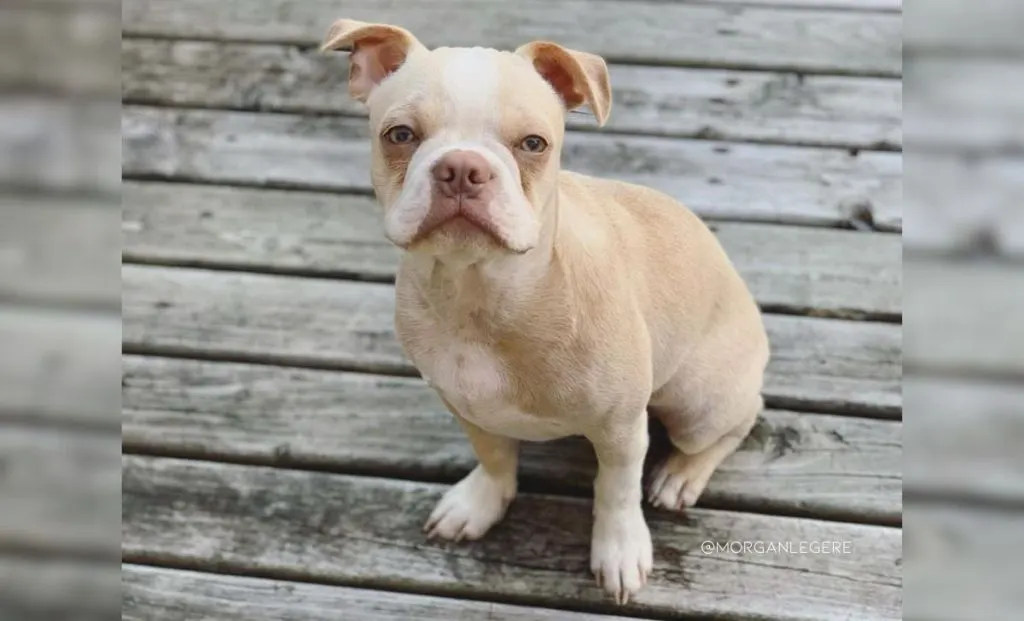
Cream and white Boston Terriers, sometimes also known as tan and white or blonde and white, are extremely rare. These adorable little pups are often confused with solid white Bostons due to the cream being so light.
They are also characterized by having light eyes that are often golden or hazel in hue, as well as butterfly noses.
The low-contrast pattern gives these terriers unique features. Many people might not realize they’re looking at Boston Terriers and instead believe they’ve run into some rare French Bulldog color!
The cream color in Boston Terriers is the result of a recessive gene, which is why it is so rare. It takes two cream parents to produce a Boston Terrier puppy of the same color.
While this isn’t a recognized color, the All Color Boston Terrier Club has requested AKC to accept cream and white. However, at the time of writing this article, there hasn’t been an answer from the AKC.
10. Lilac Boston Terrier
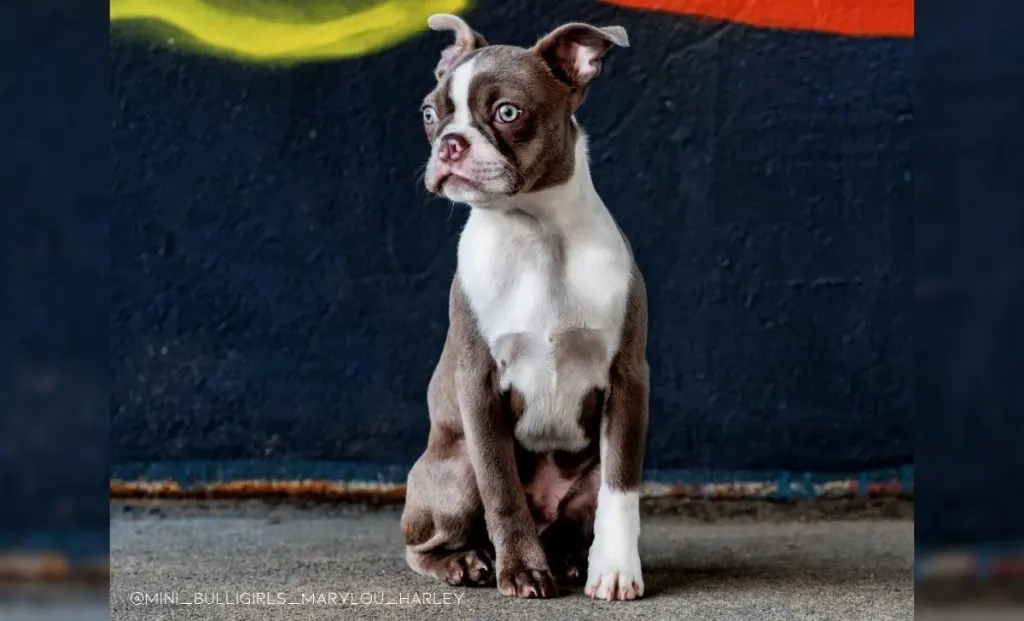
The lilac color is extremely rare in the dog world, but they are not the rarest Boston Terrier color – although they are still challenging to find.
Lilac is the result of a specific combination of dilution genes that has resulted in a mesmerizing shade of gray/cream with a slight lavender tint.
The lilac hue is most prominent on the dog’s coat, eyes, and nose, making this one of the most beautiful shades you can find.
Just like with cream, the ACBTC has suggested that lilac and cream color combination gets accepted as part of the breed standard. At the moment, however, it is still an unofficial color.
11. Merle Boston Terrier

Merle is one of the most distinguishable patterns in the dog world. Just look at how gorgeous this pup is!
It is the result of a merle gene that causes partial dilution, causing only portions of a dog’s coat to turn into a diluted shade. This results in the unique merle pattern, which looks as if the dog has splatters of various colors on its coat.
Another product of the merle gene are odd-colored eyes, also known as heterochromia.
While beautiful, there are, in fact, many things wrong with this pattern, which is why ethical Boston Terrier breeders avoid its intentional breeding.
While dogs with the merle pattern are usually as healthy as dogs with any other coat color, the problem arises when two merle dogs breed. This results in double merles, dogs that have a white coat, blue eyes, and a plethora of health problems.
Yes, when a dog gets a merle gene from both of its parents, the dilution will be too strong, affecting the dog’s eyes and ears. Such dogs are often born with hearing and vision problems and can be even entirely blind and deaf.
Sure, the solution is simply to avoid breeding two dogs with a merle pattern – but things are trickier than that.
Some dogs have a hidden merle pattern that cannot express itself, usually because there is no black color on the coat that can be visibly affected. These pups are known as cryptic merles, and they pose a true risk.
To avoid the accidental breeding of two merle pups, it is better to stay away from merles altogether – at least when it comes to Boston Terriers.
12. White Boston Terrier
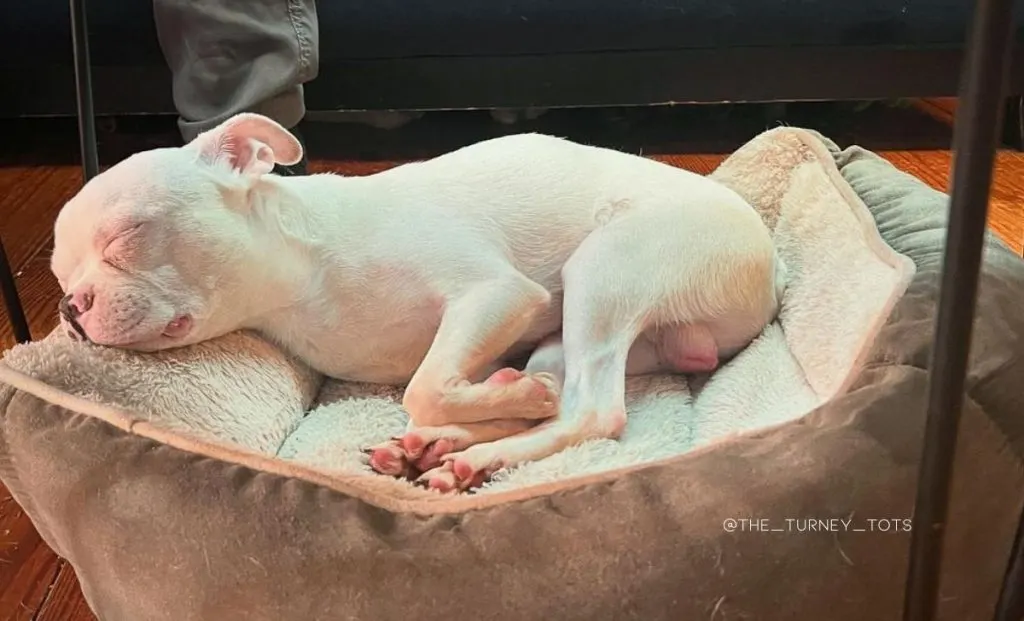
Finally, you have white Boston Terriers.
These pups are extremely rare, mostly because their breeding is frowned upon.
Some white Boston Terriers are the result of albinism, a rare condition that strips the dogs of any pigment. These dogs are recognizable not only by their white coats but also by their blue eyes with reddish tint and pink skin.
Unfortunately, dogs with albinism are prone to many health conditions, which include skin cancers, allergies, vision problems, and bone disorders.
Another potential cause of the white coat color is the merle gene. As mentioned before, double merles can also be white – but you’ve already read why this isn’t good.
Some white Bostons might even be crossbreeds and not purebred Bostons!
Finally, maybe what you’re looking at is, in fact, a cream and white Boston Terrier with a cream color so light it’s challenging to differentiate from white.
Either way, it isn’t recommended that you get a solid white Boston Terrier.
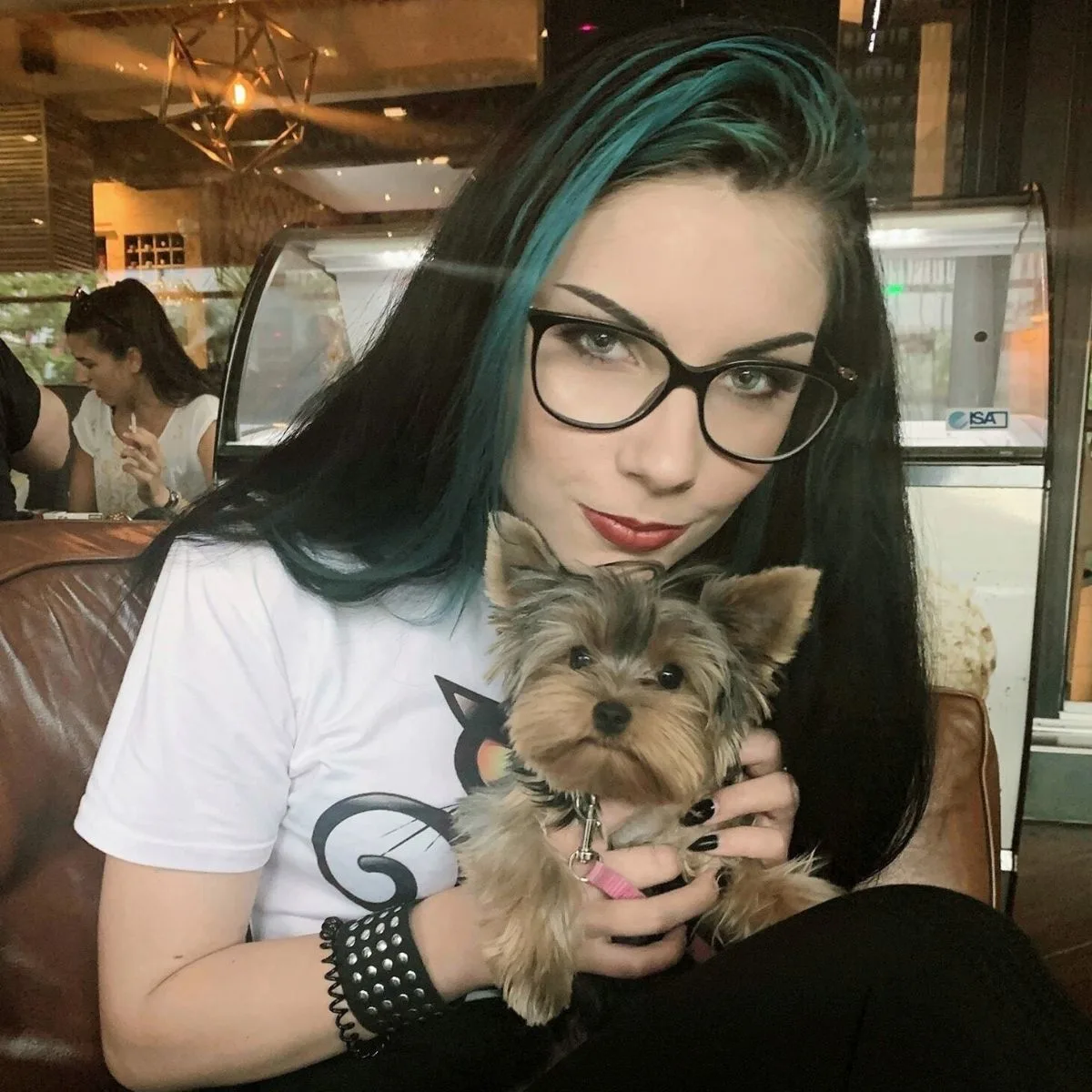
Vanja’s passion for writing started at an early age, which is why she pursued Journalism as her college degree. She can research any topic and find all the information before you bat an eye, which is a great thing for her job but a terrible one for her husband.
Even as a young child, she fell in love with everything fluffy – but dogs have a special place in her heart due to her childhood companion, a Corgie named Archie.
Motivated by her experiences and driven by a desire to give back to her four-legged companions, she spends her free time volunteering at a local dog shelter.
